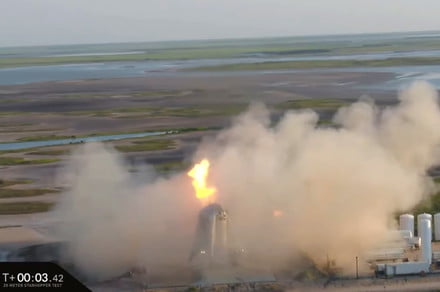[youtube https://www.youtube.com/watch?v=Xzj7w3Lnbek?feature=oembed&w=100&h=100]
SpaceX didn’t have a great day on Wednesday.
Just a short time after poor weather conditions at Cape Canaveral, Florida, forced it to call off a planned Falcon 9 launch to send supplies to the International Space Station, it was forced to abort a test launch of its Starhopper spacecraft at its Boca Chica site in South Texas.
The plan had been to send the Starhopper — a prototype of its next-generation Starship spacecraft — 20 meters (65 feet) into the air before returning to terra firma under its own power and using its own on-board technology in what would have been its first untethered lift off and landing following two tethered launches in April 2019.
The Starhopper’s single Raptor engine appeared to fire up as planned at T-minus zero, but it didn’t leave the ground. Worse than that, flames suddenly appeared at the top of the spacecraft as smoke billowed around it. We’ve reached out to SpaceX to find out what went wrong and will update this article if we hear back.
Commenting during a livestream of Wednesday’s failed effort, SpaceX engineer Kate Tice said: “It appears as though we have had an abort on today’s test,” adding, “As I mentioned before, this is a development program — today was a test flight designed to test the boundaries of the vehicle.”
The hiccup came a week after a failed static-fire test of the Starhopper’s engine, which is fueled by liquid methane and liquid oxygen. In that incident, a large fireball engulfed the spacecraft, but its high-strength stainless steel build appeared to shield it from any serious damage.
Starship and Super Heavy
The Starhopper has been built to test technology destined for SpaceX’s much bigger Starship spacecraft, which will have not one but six Raptor engines. The Starship vehicle forms part of the enormous Super Heavy that features 35 Raptor engines, making it the most powerful rocket if SpaceX can meet its goals.
The plan is to use its reusable rocket system for crewed space trips of up to 100 people at a time.
SpaceX CEO Elon Musk claimed last week that the Starship could make a moon landing as early as 2021, with a crewed mission following a year or two later. He also floated the idea of building a “permanently occupied lunar base” for scientific research, with trips to Mars also a possibility.
The system could be used for space tourism, too, with one wealthy Japanese businessman already having paid an undisclosed amount for a trip around the moon in the coming years.
Wednesday’s failed test shows there’s still much work to be done on its next-generation rocket system, but with SpaceX having achieved so much up to now, few would bet against the Super Heavy transforming space travel as we know it.
Editors’ Recommendations
- SpaceX’s Starhopper rocket bursts into flames during tests
- Elon Musk says SpaceX’s Starship can land on the moon by 2021
- SpaceX hopes to blast off its Starship and Super Heavy Rocket project in 2021
- Watch NASA test the Orion spacecraft’s emergency escape system live
- Watch today’s SpaceX CRS-18 Falcon 9 rocket launch to bring equipment to the ISS

